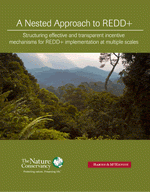A Nested Approach to REDD+
Structuring effective and transparent incentive mechanisms for REDD+ implementation at multiple scales
By Rane Cortez, Rick Saines, Bronson Griscom, Marisa Martin, Daniel De Deo, Greg Fishbein, John Kerkering, Duncan Marsh - The Nature Conservancy, Baker & McKenzie, LLP, The Nature Conservancy, Baker & McKenzie, LLP, Baker & McKenzie, LLP, The Nature Conservancy, The Nature Conservancy, The Nature Conservancy View PublicationIn order for REDD+ to be successful, incentives will need to reach the actors responsible for addressing the drivers of deforestation and for shifting land use to a more sustainable and lowcarbonmodel. These actors span multiple scales, from international commodity buyers to national governments to subânational governments to indigenous peoples and forestâdependent communities to individual landowners/users.
Devising effective and transparent carbon accounting systems and incentive mechanisms that motivate both national and subânational actors will be critical to successfully implementing REDD+.
A nested approach to REDD+ is one way to structure such a system. Under a nested approach the national government could set up a national accounting framework and establish a nationwide monitoring system. The national government could implement certain policy reforms that would lead to verifiable emission reductions and therefore earn incentives from an international system (or a bilateral arrangement). Meanwhile, implementation of REDD+ activities could also occur at the subânational level led by local/regional governments, communities, NGOs, or private developers. These activities would account for emission reductions at the subânational level and earn incentives directly from the international (or bilateral) system based on those reductions. Under the approach proposed in this paper, the subânational accounting would need to be �truedâup� to the national level (i.e. all credits issued in any given year are based on the performance of the nation as a whole relative to its reference emission level).
A nested approach to REDD+ has the potential to address many of the drawbacks of pure national or pure subânational approaches by accounting for inâcountry leakage, engaging national governments, and taking advantage of certain economies of scale, while also motivating subânational actors to participate in REDD+ and attracting greater privateinvestment. A nested approach may also provide for a more transparent distribution of thebenefits from REDD+ since local actors could own and transact credits directly rather than relying on a national system of benefitâsharing. However, a nested approach will likely requiremore complex carbon accounting methodologies, clearly defined systems for sharing risk between actors, and defined institutional arrangements for managing the flow of incentives.
Nested carbon accounting should include the following elements: a clear national reference emission level, defined subânational reference regions (nonâoverlapping areas that cover the entire land mass of the country designated based on common drivers of deforestation and political jurisdictions), and, in some cases, nested projects whose reference emission levels add up to the reference region and hence the national reference emission level.
Under the nested approach we propose in this paper, there is a risk that subânational actors may not receive compensation for successful activities in the event that the country as a whole fails to perform. This risk will need to be minimized in order to promote subânational participationand private investment. This paper outlines several options for risk management among actors, including insurance products, a global selfâinsurance fund, performance reserve accounts, or contracts between parties for replacement of REDD+ credits.
These options could be combined to meet the needs of particular country circumstances. The set of options chosen could lead to a greater assumption of risk by the national government, an even distribution of risk between actors, or a greater assumption of risk by subânational actors. Several plausible arrangements exist, and the set of options chosen will greatly influence the level of subânational involvement and private investment.
Given the potential advantages of a nested approach to REDD+, an international agreement on REDD+ and domestic legislation in the U.S. and other developed countries should allow developing countries the option to pursue a nested approach to REDD+ backed by adequate risk management strategies. Developing country governments should consider a nested approach to REDD+ when devising their national REDD+ strategies.

